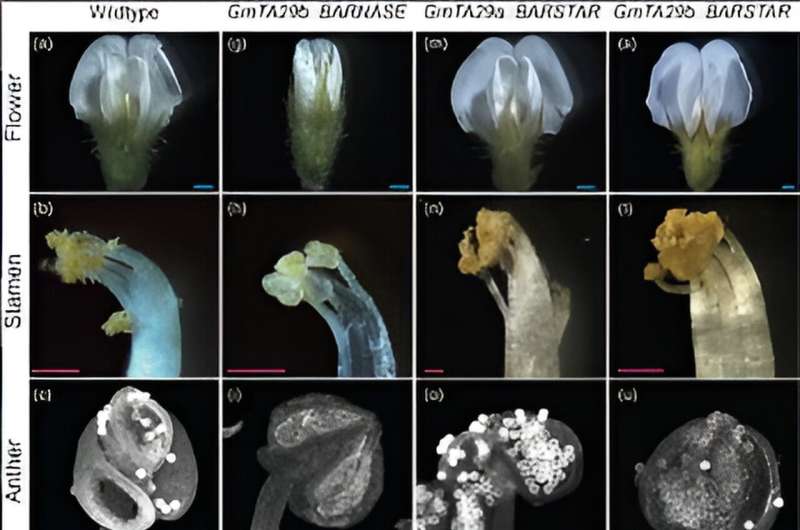This article has been reviewed according to Science X's editorial process and policies. Editors have highlighted the following attributes while ensuring the content's credibility:
fact-checked
peer-reviewed publication
trusted source
proofread
New research identifies a biotechnology approach to improve hybrid breeding of soybean

Soybean (Glycine max) is one of the most economically and societally impactful crops in the world, providing a significant percentage of all protein for animal consumption on a global scale, and playing key roles in oil production, manufacturing, and biofuel applications. In 2022, an estimated 4.3 billion bushels of soybeans were produced in the United States, a decrease of almost 200 million bushels compared to the previous year.
To keep up with the growing demand for soy-based animal feed, the USDA projects soybean acreage will increase by 19.6% by 2032. Hybrid breeding in soybean has the potential to increase the productivity of one of the most planted and consumed crops in the Americas, yet it has remained largely unexplored.
New research by scientists at the Donald Danforth Plant Science Center and Cornell University provides a key enabling technology to produce obligate outcrossing in soybean. The newly published study, "Introduction of barnase/barstar in soybean produces a rescuable male sterility system for hybrid breeding" in the Plant Biotechnology Journal, has revealed that obligate outcrossing with the Barnase/Barstar lines provides a new resource that can be used to amplify hybrid seed sets, enabling large-scale trials for heterosis in this major crop.
Currently, soybean is 99% self-pollinated, preventing any gains from hybridizing. Hybrid breeding for increased vigor has been used for over a century to boost agricultural outputs without requiring higher inputs. While this approach has led to some of the most substantial gains in crop productivity, breeding barriers have fundamentally limited soybean from reaping the benefits of hybrid vigor.
Soybean makes inconspicuous flowers that self-fertilize before opening, and thus are not readily amenable to outcrossing. This is in part due to the limitations of current approaches, which have failed to produce reliable obligate outcrossing in soybean.
The research team demonstrated that the Barnase/Barstar male-sterility/male-rescue system can be used in soybean to produce hybrid seed. By expressing the cytotoxic ribonuclease, Barnase, under a tapetum-specific promoter in soybean anthers, they were able to completely block pollen maturation, creating male-sterile plants. They also showed that fertility can be rescued in the F1 generation of these Barnase-expressing lines when they are crossed with pollen from plants that express the Barnase inhibitor, Barstar.
"Importantly, we found that successful rescue of male-fertility is dependent on the relative dosage of Barnase and Barstar. When Barnase and Barstar were expressed under the same tapetum-specific promoter, the F1 offspring remained male-sterile. When we expressed Barstar under a relatively stronger promoter than Barnase, we were able to achieve successful rescue of male-fertility in the F1 generation," said Patricia Baldrich, Ph.D., co-author on the work and Danforth Center principal investigator.
This work demonstrates the successful implementation of a biotechnology approach to produce fertile hybrid offspring in soybean. Given the importance of soybean to global agriculture, advances in soybean productivity could have a transformative impact, and promote sustainable agriculture by enabling farmers to produce higher yields on existing acreage.
"Improved soybean is a long-term goal of farmers, plant breeders, and scientists," says Blake Meyers, Ph.D., Danforth Center principal investigator and professor of plant science at the University of Missouri. "Improvements could have a potentially substantial effect—and offer a benefit to beleaguered pollinators as well."
"This work is the first step towards developing a hybrid breeding system for soybean. Watching Nicole Szeluga, Ph.D. student at Cornell University and lead author on this paper, take the project from design to fruition has made me really proud. I'm excited to see how the team project develops in the coming years," says corresponding author Margaret Frank, Ph.D., Cornell University assistant professor in the School of Integrative Plant Sciences.
Cross-pollinated soybeans have the potential to boost yield thanks to so-called "hybrid vigor," provide forage for pollinators, and allow farmers to produce more soybeans on less land. To achieve this aim, the team is now working on additional soybean flower traits, that when stacked or combined with the male sterile lines, will represent a systematic approach to enable the production of hybrid soybean seeds.
"As a graduate student, I find immense satisfaction in observing the continuous evolution of this project, from conceptualization to experimentation, followed by thorough data analysis and a publication. I am excited to be part of research that holds the potential to bring about impactful changes in the world," added Ryan DelPercio, USDA-NIFA-AFRI predoctoral fellow at the University of Missouri and member of the Meyers laboratory.
More information: Nicole Szeluga et al, Introduction of barnase/barstar in soybean produces a rescuable male sterility system for hybrid breeding, Plant Biotechnology Journal (2023). DOI: 10.1111/pbi.14155
Journal information: Plant Biotechnology Journal
Provided by Donald Danforth Plant Science Center




















